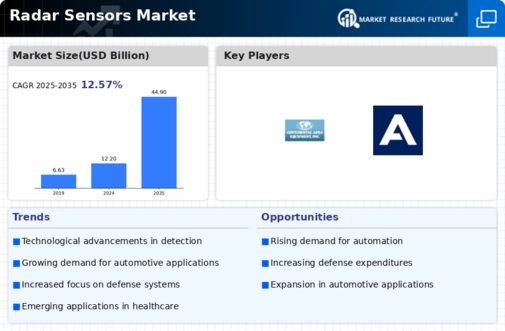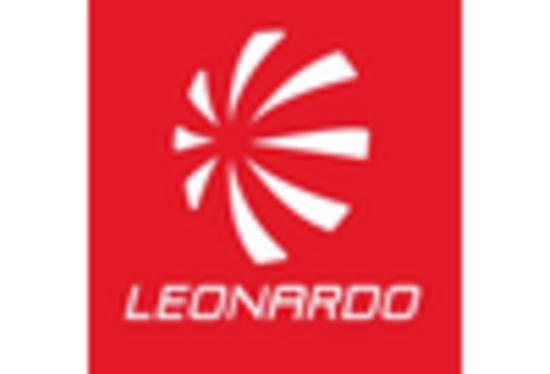Market Analysis
Radar Sensors Market (Global, 2024)
Introduction
The Radar Sensors Market is poised to experience significant advancements driven by the increasing demand for enhanced safety and security measures across various sectors, including automotive, aerospace, and defense. As technology continues to evolve, radar sensors are becoming integral components in applications such as autonomous vehicles, traffic management systems, and surveillance operations. The ability of radar sensors to operate effectively in diverse environmental conditions, coupled with their precision in detecting objects and measuring distances, positions them as a critical asset in modern technological frameworks. Furthermore, the growing emphasis on smart city initiatives and the integration of Internet of Things (IoT) solutions are expected to further propel the adoption of radar sensor technologies. This market analysis delves into the key trends, challenges, and opportunities that are shaping the landscape of radar sensors, providing a comprehensive overview of the factors influencing their development and deployment in various industries.
PESTLE Analysis
- Political
- In 2024, the political landscape surrounding the radar sensors market is heavily influenced by government defense spending, which is projected to reach $1.2 trillion globally. Countries are increasingly investing in advanced surveillance and defense technologies, with the U.S. Department of Defense alone allocating approximately $300 billion for modernization efforts, including radar systems. Additionally, international trade policies and tariffs on electronic components can impact the supply chain, as seen with the 15% tariff imposed on certain electronic imports in the U.S. in 2023, which continues to affect pricing and availability in 2024.
- Economic
- The economic environment for the radar sensors market in 2024 is characterized by a global electronics market valued at $1.5 trillion, with radar sensors being a critical component in various applications. The average cost of radar sensor systems ranges from $10,000 to $50,000, depending on the complexity and application, which influences purchasing decisions across industries. Furthermore, the unemployment rate in the technology sector is estimated at 4.2%, indicating a stable labor market that supports innovation and development in radar technologies.
- Social
- Social factors impacting the radar sensors market in 2024 include the increasing public awareness of safety and security issues, leading to a heightened demand for surveillance technologies. Surveys indicate that 68% of consumers are more likely to support businesses that utilize advanced security measures, including radar sensors. Additionally, the growing trend of smart cities, with over 500 cities worldwide implementing smart technologies, is driving the adoption of radar sensors for traffic management and public safety applications.
- Technological
- Technological advancements are rapidly shaping the radar sensors market in 2024, with the introduction of solid-state radar technology, which is expected to reduce costs by up to 30% compared to traditional systems. The integration of artificial intelligence (AI) in radar systems is also on the rise, with an estimated 40% of new radar products incorporating AI capabilities for enhanced data processing and analysis. Furthermore, the development of 5G technology is facilitating faster data transmission, which is crucial for real-time radar applications.
- Legal
- Legal factors affecting the radar sensors market in 2024 include stringent regulations regarding data privacy and security. The General Data Protection Regulation (GDPR) in Europe imposes fines of up to €20 million or 4% of global turnover for non-compliance, which impacts how radar data is collected and processed. Additionally, the Federal Communications Commission (FCC) in the U.S. has established guidelines for the use of radar frequencies, requiring manufacturers to adhere to specific standards to avoid interference with other communication systems.
- Environmental
- Environmental considerations are increasingly relevant in the radar sensors market in 2024, with a growing emphasis on sustainability and energy efficiency. The global push for reducing carbon emissions has led to the implementation of regulations that require radar systems to meet energy consumption standards, with a target of reducing energy use by 20% by 2030. Moreover, manufacturers are investing in eco-friendly materials, with an estimated 25% of new radar sensor products being designed with recyclable components to minimize environmental impact.
Porter's Five Forces
- Threat of New Entrants
- Medium - The radar sensors market has moderate barriers to entry due to the need for significant capital investment in technology and research and development. While there are opportunities for new players, established companies with strong brand recognition and customer loyalty pose a challenge for newcomers. Additionally, regulatory requirements and the need for specialized knowledge can deter new entrants.
- Bargaining Power of Suppliers
- Low - The bargaining power of suppliers in the radar sensors market is relatively low. There are numerous suppliers of raw materials and components, which allows manufacturers to switch suppliers easily if needed. This abundance of options diminishes the suppliers' ability to exert significant influence over pricing and terms.
- Bargaining Power of Buyers
- High - Buyers in the radar sensors market have high bargaining power due to the availability of multiple alternatives and the increasing demand for advanced technology. Customers, particularly large corporations and government entities, can negotiate better prices and terms, as they often purchase in bulk and have specific requirements that can drive competition among suppliers.
- Threat of Substitutes
- Medium - The threat of substitutes in the radar sensors market is moderate. While radar sensors are widely used in various applications, alternative technologies such as LiDAR and infrared sensors can serve similar purposes. However, the unique advantages of radar technology, such as its ability to operate in adverse weather conditions, limit the immediate threat from substitutes.
- Competitive Rivalry
- High - Competitive rivalry in the radar sensors market is high, with several key players vying for market share. The rapid technological advancements and the increasing demand for automation and smart technologies drive intense competition. Companies are constantly innovating and improving their products to differentiate themselves, leading to aggressive marketing strategies and pricing wars.
SWOT Analysis
Strengths
- High accuracy and reliability in object detection and tracking.
- Growing demand in automotive and aerospace industries for safety and navigation.
- Technological advancements leading to miniaturization and cost reduction.
- Ability to operate in various weather conditions, enhancing versatility.
Weaknesses
- High initial investment costs for advanced radar systems.
- Limited awareness and understanding among potential end-users.
- Complex integration with existing systems and technologies.
- Potential interference issues with other electronic devices.
Opportunities
- Increasing adoption of autonomous vehicles driving demand for radar sensors.
- Expansion into emerging markets with growing industrial sectors.
- Development of smart city initiatives requiring advanced sensing technologies.
- Rising interest in defense and security applications boosting market growth.
Threats
- Intense competition from alternative sensing technologies like LiDAR and cameras.
- Regulatory challenges and compliance requirements in different regions.
- Economic fluctuations impacting investment in technology sectors.
- Rapid technological changes leading to obsolescence of existing products.
Summary
The Radar Sensors Market in 2024 is characterized by its strengths in accuracy and reliability, particularly in automotive and aerospace applications. However, high initial costs and integration challenges pose significant weaknesses. Opportunities abound with the rise of autonomous vehicles and smart city projects, while threats from competing technologies and regulatory hurdles could impact growth. Strategic focus on innovation and market education will be crucial for stakeholders to navigate this dynamic landscape.


















Leave a Comment